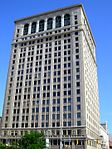Maxine Goodman Levin College of Urban Affairs

The Maxine Goodman Levin College of Urban Affairs (Levin) is an accredited college of urban studies, public administration, urban planning, environmental studies, and nonprofit management at Cleveland State University located in Cleveland, Ohio. The Levin College offers undergraduate, graduate, and doctoral degrees, as well as professional development programs. Its urban policy research centers and programs provide communities with decision-making tools to address their policy challenges. The Levin College is recognized for offering highly ranked programs in urban policy, local government management, nonprofit management, and public management and leadership.The Levin College is located on the Cleveland State University campus housed on the historic Euclid Avenue in The Playhouse Square District in downtown Cleveland. In 2016, Roland V. Anglin, previously the senior advisor to the chancellor and director of the Joseph C. Cornwall Center for Metropolitan Studies at Rutgers University-Newark, was named dean.
Excerpt from the Wikipedia article Maxine Goodman Levin College of Urban Affairs (License: CC BY-SA 3.0, Authors, Images).Maxine Goodman Levin College of Urban Affairs
Euclid Avenue, Cleveland
Geographical coordinates (GPS) Address Nearby Places Show on map
Geographical coordinates (GPS)
| Latitude | Longitude |
|---|---|
| N 41.501611111111 ° | E -81.679722222222 ° |
Address
Levin College of Urban Affairs
Euclid Avenue 1717
44114 Cleveland
Ohio, United States
Open on Google Maps










